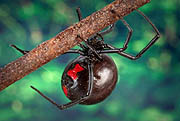| Home A B C D E F G H I J K L M N O P Q R S T U V W X Y Z |
|
Home |
Black Widow Spider Bite: Symptoms
|
|
|
|

Latrodectus is a genus of spider, in the family Theridiidae, that contains approximately 31 recognized species. The common name widow spiders is sometimes applied to members of the genus due to the supposed habit of the female of eating the male after mating, although the males of most species are not actually usually eaten after mating, and can even go on to fertilize other females.
The black widow spiders are perhaps the best-known members of the genus. The injection of neurotoxic venom Latrotoxin from these species is a comparatively dangerous spider bite, resulting in the condition Latrodectism which is named for the genus. The female black widow's bite is particularly harmful to humans because of its unusually large venom glands.
SYMPTOMS:
Within a short time the victim feels agonizing pain throughout the body, especially in the abdomen, which may be rigid as a board. Abdominal pain similar to that of appendicitis. Cold sweats, difficulty in breathing, nausea, spastic muscle contractions, vomiting, localized tissue ![]() , and sometimes delirium and convulsions occur.
, and sometimes delirium and convulsions occur.
CAUSES:
There are more than 29,000 known types of spiders. They are excellent at insect control; but two in the U.S. are extremely dangerous. The tarantula is the world’s largest spider; it lives as far north as the southwestern U.S. But its bite is no more dangerous to a human that the sting of a bee or wasp.
Black widow venom is more potent, drop for drop, than the poison of a pit viper (rattlesnake, copperhead, or cotton mouth); yet each spider bite injects only an extremely small amount of venom. Four out of every 100 people bitten by a black widow have anaphylactic shock and ![]() . It is possible to develop tetanus from a spider bite.
. It is possible to develop tetanus from a spider bite.
|
Glossary References Links Contact
|